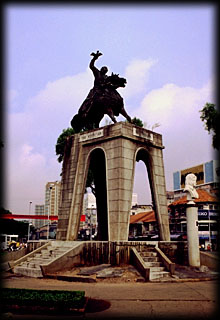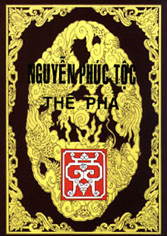 Leaders
Leaders Leaders
Leaders
| Ngo Quyen --- Repel leader who restored Vietnamese independence from Chinese rule in A.D. 939. Ngo Quyen, son of a provincial official and a native of the western Red River Delta near Mount Tan Vien, became a military commander and a son-in-law of Duong Dinh Nghe, who had seized control of Vietnam in the unstable conditions following the collapse of the T'ang Empire in China. After Dinh Nghe was assassinated in 937, Ngo Quyen launched an attack on the troops loyal to the assassin and a Chinese army which supported him. At the mouth of the Bach Dang River, at the entrance ot the Tonkin Gulf, Quyen won a major victory by sinking wooden poles into the mud at the mouth of the river. When the tide fell, the Chinese fleet was impaled on the poles and destroyed. |

| Tran Hung Dao ---
(1213-1300), Famous
general who defeated two Mongol invasions in late thirteenth-century Vietnam.
A prince in the Tran royal family, in 1287 he was appointed commander-in-chief
of the Vietnamese armed forces in the face of the growing threat of a Mongol
invasion. Asked by Emperor Tran Nhan Tong whether the Vietnamese
Empire should appease the Mongols rather than fight, Tran Hung Dao had
replied with a famous declaration in which he
appealed to his sovereign and to the population at large, for a policy
of national resistance.
Tran Hung Dao is viewed today as one of the truly great military strategists in Vietnamese history. His use of guerrilla warfare to harass a more powerful enemy became a model for revolutionary military planners of the twentieth century. |
| Quang Trung --- (1752-1792), Leader of Tay Son Rebellion and founding emperor of the Tay Son Dynasty in late eighteenth-century Vietnam. Nguyen Hue was the second eldest of three brothers from the village of Tay Son in An Khe District, Nghia Binh Province in Central Vietnam. The family, originally from Nghe An Province and reportedly descendents of the fifteenth-century figure Ho Quy Ly, were farmers and small merchants. In the early 1770s the brothers, led by the eldest Nguyen Nhac, revolted against the rule of the Nguyen Lords, who controlled the southern provinces of Vietnam in the name of the Later Le Dynasty. In 1785, Tay Son seized the Nguyen capital of Saigon and began to move against the Trinh Lords, who controlled the North. Marching under the slogan of "Restore the Le, destroy the Trinh," Nguyen Hue seized the imperial capital of Thang Long in July 1786. At first, Nguyen Hue kept his campaign slogan and recognized the legitimacy |
Ao vai Co dao.
Ai nguoi ao vai danh bai quan
Thanh!


 Sign
My Guestbook
Sign
My Guestbook